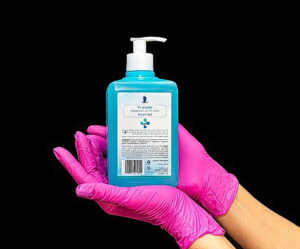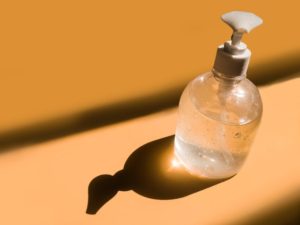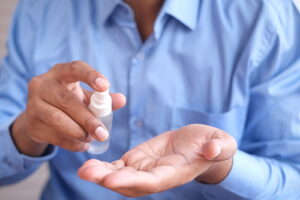
Little Johnny was touching everything in the store and his mother wasn’t happy, especially during this period of coronavirus. Not so much for the fact that she had to repeatedly tell him to stop, but also because she needed to repeatedly wash his hands so that he doesn’t get infected with Covid and now, Monkey Pox as well.
So How Do Hand Sanitizers Work Anyway? What’s in it? Let’s take a look!

Hand sanitizers kill germs on the skin using a high concentration of alcohol. When applied to the hands, the alcohol goes onto the skin and evaporates, but it leaves behind the disinfectant properties.
This process is called rapid evaporation. During rapid evaporation, the alcohol concentration on the skin is much higher than normal, which is why it kills germs so effectively. Normally, it would take much longer for alcohol to evaporate from the skin and be effective against germs. The alcohol in hand sanitizers is mixed with oil to slow down the evaporation time and give your hands a longer-lasting antiseptic effect.
Most hand sanitizers contain 60-90% alcohol as the primary active antiseptic ingredient, with other additives mostly being emollients, preservatives, and fragrances.
There are also some non-alcoholic hand sanitizers available, which use different active ingredients to kill bacteria such as ethyl vinegar, oils of lemon and eucalyptus, triclosan, and chloroxylenol.
Read on to know more about the ingredients in hand sanitizers.
Isopropyl Alcohol
Isopropyl alcohol (IPA), also known as rubbing alcohol is an antiseptic, which means that it prevents the growth of microorganisms that can cause diseases. And as so, is very effective against many viruses, including Covid.
IPA is a synthetic compound that is chemically similar to ethanol (alcohol), which is also an antiseptic but usage of IPA is more common. Neither alcohols are suitable for human consumption due to their toxic nature and consuming it can lead to death, and more caution should be made when buying these disinfectants that were manufactured outside the United States.
So they must be kept out of reach of children and any furry friends that you may have. With that said, both antiseptics are safe to use on the skin.
Other Ingredients
Additional ingredients in hand sanitizers are emollients, preservatives, and fragrances.
-
-
- Emollients are substances that are added to hand sanitizers to make them less drying, so they don’t leave cracked, flaky skin. This can be useful for people who wash their hands frequently, such as people who work in healthcare or food services.
- Preservatives are used to prevent bacteria, molds, and fungi from growing in the product. It is important to avoid using hand sanitizers that do not contain a preservative, as they can grow bacteria if you don’t close the cap after each use.
- Fragrances are used to give the product a pleasant smell. It should be noted that not all fragrances are mild and some have been shown to have health effects on some people. It is best to look for a fragrance-free option or one with a scent that you do not have an allergy to.
-
Diethylene Glycol
Diethylene glycol is a synthetic liquid that is used in hand sanitizers as a solvent, or something used to dissolve other substances. It is also used in antifreeze and some engine coolants. Although diethylene glycol is not directly toxic to humans, it is a byproduct of ethylene oxide, which is a known carcinogen.
Pros of Using Hand Sanitizer
-
-
- They are portable, so you can clean your hands anywhere, from airport restrooms to the park, without having to find a sink
- They are generally easier to use than hand washing, especially when you’re in a rush
- May be less drying on the skin than regular soap and water
- They don’t require hot water, so they can be used in cold weather when your hands are particularly dry
- Useful for people who have skin allergies or conditions that make it difficult to wash their hands properly
- Can help prevent the spread of many infectious diseases.
- They are useful for kids who are in daycare or school
-
Cons of Using Hand Sanitizer
-
-
- They may not kill all the germs on your hands
- Doesn’t replace proper hand washing. Hands should be washed with soap and water as often as possible
- Hand sanitizers can dry out the skin, leaving hands cracked and itchy
- Alcohol-based hand sanitizers can cause skin allergies in some people
- Hand sanitizers are more expensive than regular hand washing
-
Tips for Choosing the Right Hand Sanitizer
-
-
- When shopping for a hand sanitizer, look for one with an alcohol concentration of 60% or more
- The higher the concentration, the more effective it will be at killing germs
- Read the ingredients list on the label and make sure you understand what each ingredient does in the product
- When choosing a fragrance, think about what you like. There is no evidence that one fragrance is healthier than another
- When it comes to choosing a size, think about where you will carry it. If you will keep it in your purse, you may want a smaller bottle, while a larger bottle may be best for your car or desk drawer.
-
Conclusion

Hand sanitizers can be useful when you can’t wash your hands properly and they are pretty good disinfectants; however, they don’t kill all the germs present on your hands, so they do not replace proper hand washing when you can.
It is important to choose the right-hand sanitizer for you. There are many different types available, with different alcohol concentrations and fragrances, but whatever you choose, each time you wash your hands with these disinfectants, it is one more time you can have better peace of mind that you are lowering your risk of getting ill.

